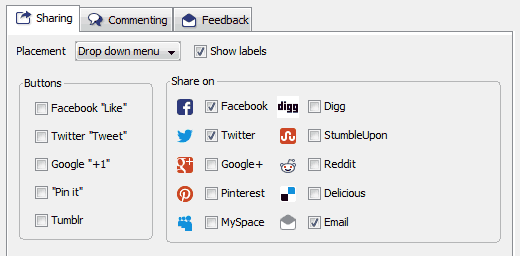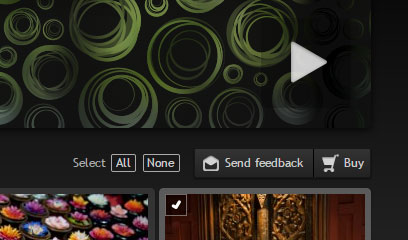Social
Sharing

- Placement
-
- Drop down menu
– The sharing options will be collected in a box, which appears when the visitor moves the mouse over the Share button.

- Unboxed – All the sharing options will be visible above the thumbnail area on the index page.

- Drop down menu
– The sharing options will be collected in a box, which appears when the visitor moves the mouse over the Share button.
- Show labels
-
Whether or not to show the social site's name along its icon. Applies to Share on buttons.
-
Social buttons that work straight from their parent site. No other interaction is needed besides pressing the
Like
orTweet
button.Please note, these buttons load huge external libraries on every page. If you enable many of them, the page load time might suffer. It's advisable to avoid using more than 2 of these buttons.
In order these buttons to work properly you need to specify the Upload path upfront. If you have uploaded the album at least once, Turtle can guess the upload path itself.
The social buttons don't work for individual images in Dynamic mode because the images are presented on the same HTML page upon user interaction, and these are only the internal states of the same HTML page. Social sites prefer HMTL pages as is, no internal states. If individual Like or Share buttons are important in the album use the Separate slides mode.
If something won't work properly on Faceook use Facebook's debugger tool to find if there was any errors in the album. This tool is useful for flushing Facebook's cache too, for example when it has cached something wrong.
-
Links to social site's sharing pages. By pressing these buttons you will be redirected to the sharing page on the social site.
Please note, you can't share a dynamic album's internal state, i.e. an individual picture on Facebook and Google Plus, only the index page. This is why no such buttons generated below the images.
Commenting

Facebook commenting
- Enable Facebook commenting
-
Turn on to enable the Facebook commenting tool on Index page, Slide page or Both.
Please note, Facebook commenting on individual images in not possible in Dynamic mode.
- Facebook App ID
-
You will need to create a new App for your web site in order you can enjoy Facebook's commenting tool. Visit this page and create a new
Web application
. Copy paste theApplication ID
in this box. - Number of posts to show
-
The number of posts displayed in the initial view. Facebook will show all the comments if you scroll down.
Please note, not all comments appear every time, and not in the order they were added. Facebook uses its
Edge rank
algorythm to filter the messages based on importance. - Administrators
-
The names of the administrators (as used on Facebook). Please leave this field empty, as the Admins can now be managed through your dashboard. This box has left only for compatibility reasons.
Disqus commenting
- Enable Disqus commenting
-
Turn on to enable the Disqus commenting tool on Index page, Slide page or Both.
Please note, Disqus commenting on individual images in not possible in Dynamic mode.
- Disqus short name
-
Sign up with Disqus and click Add Disqus to your site. Copy/paste the short site name you gave during the process in the
Choose your unique Disqus URL
box.
Feedback

- Your email
-
The email address you wish to receive the feedback.
The email address is obfuscated in the page code, so robots cannot easily extract it.


Please note, as a webpage cannot pass more than 4096 bytes to the email application (due to security reasons), the number of images is limited to cca. 20-25. If you go above this limit Turtle will warn you when you try to Send.